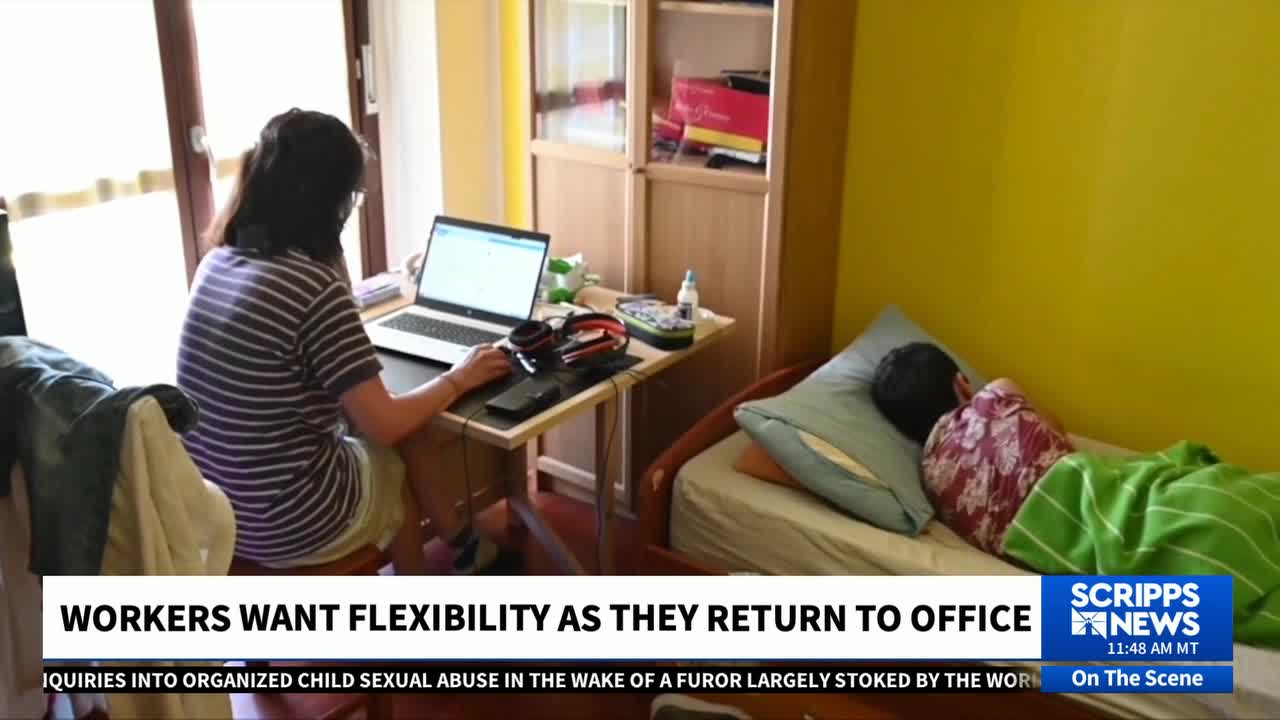More remote workers are being called back to the office in the private sector and the federal government. But the new rules don’t always apply to everyone.

Workers seek flexibility as employers implement return-to-office mandates
Despite technological advancements and a preference for flexibility among American workers, employers are pushing for a return to the office.
Scripps News
When ride-sharing company Uber increased the number of days employees had to show up in person from two to three, the return-to-office mandate set off a fiery backlash. In an all-hands meeting and then in online forums, the rank-and-file groused they were being summoned back to work while many corner offices sat empty.
Soon, another brouhaha erupted at JPMorgan Chase. After thousands of employees at the world’s largest bank were ordered back to the office five days a week, word leaked that Filippo Gori would now run business affairs in Europe, the Middle East and Africa from New York, not from Dubai, Johannesburg or London. JPMorgan Chase did not comment.
With employers cracking down on how many days a week people can work from home, office workers are calling out what they say is a double standard: Executives who enforce in-person work for their teams but reserve the right to work wherever they please.
Salesforce’s Marc Benioff is one of those CEOs who self-identifies as a remote worker. “I’ve always been a remote worker my whole life,” Benioff told MSNBC in 2023. “I don’t work well in an office. It just doesn’t work with my personality. I can’t tell you why.”
His employees often don’t have that luxury. In September, they were told to return to the office at least three days a week. Benioff said the message is to “mix in-person and remote together.” Salesforce did not respond to a request for comment.
“Regardless of how you feel about remote work, you have to laugh at the nerve of these types of people who are being compensated millions of dollars per year to implement ‘rules for thee and not for me,’” one Uber employee commented on Blind, an anonymous app for professionals.
‘Like the key to the executive toilet’
Many office workers got hooked on remote work as the COVID-19 pandemic shut down offices across America. With only “essential” frontline workers required to show up in person, the white-collar workforce skipped rush hour and cocooned at home.
Prioritizing once elusive goals such as quality of life, they relocated in droves to more affordable places such as Salt Lake City and Boise, Idaho. Their new schedules made life much easier to balance, especially for parents of young children and workers with disabilities, while research frequently showed the pandemic-induced work arrangements had other benefits. Employees who worked from home were happier and as – if not more – productive.
Five years later, a growing number of companies from Amazon to Ford are winding back the clock on remote work – but not for everyone.
Flexibility is fast becoming an elite perk, with some top executives running their businesses hundreds or thousands of miles from the home office from the comfort of their own home office.
Last year, Starbucks lured Brian Niccol from Chipotle Mexican Grill with a $10 million cash signing bonus, a $75 million stock award and a $1.6 million annual salary, making him one of the highest-paid CEOs in America. But none of his eye-popping perks got as much attention as the work-from-home deal he cut.
Even as other corporate workers in the coffee chain’s Seattle headquarters were told to work in the office three days a week, Niccol didn’t pull up stakes. Instead, he commutes 1,600 miles from his Newport Beach, California, home on the company’s private jet and on its dime.
Starbucks said its CEO, who engineered the “Back to Starbucks” turnaround plan to rebound from a prolonged sales slump, maintains an office and home in Seattle but prioritizes an active schedule visiting coffeehouses, roasting plants, support centers and business partners around the globe.
Still, that special treatment irks employees. A 2023 Wall Street Journal report that Boeing Chief Financial Officer Brian West, the second-highest-ranking executive at the company, worked from a small office about five minutes from his home in New Canaan, Connecticut, and hundreds of miles from the company’s Arlington, Virginia, headquarters, caused a stir. West has maintained that arrangement even after many staffers were told to return to the office.
According to securities filings, Boeing provided $42,271 worth of flights on company aircraft last year for West, whose total compensation was nearly $6.2 million. Boeing declined to comment.
Management experts say it matters far less where key executives log into work each day. After all, they often live out of suitcases while jetting to far-flung offices and calling on customers. But permitting executives to live and work remotely conflicts with the messaging that businesses benefit the most when employees show up in person.
Like most sought-after workplace perks, flexibility is largely a function of power and pay, according to Stanford University economics professor Nick Bloom, who studies remote work.
Higher-income workers are more likely to have remote work arrangements than those at the lower end of the pay scale, his research shows. Just 5% of workers making $10,000 to $50,000 a year live 50 or more miles from their office, compared to 14% of those earning over $250,000.
“Before the pandemic, working from home was a predictor of low pay. We used to joke about it. Is he working from home or shirking from home?” Bloom said. “Now it’s like the key to the executive toilet. Being able to work from home is something that people are flexing about.”
Some workers, CEOs buck return to office
A similar phenomenon is playing out in the public sector. President Donald Trump made splashy headlines when he ordered federal workers back to the office full-time. But, said Bloom, Trump often prefers his Mar-a-Lago estate in Florida to the Oval Office.
The president is far from alone. A 2023 McKinsey survey found the largest share of employees who strongly prefer working from home earn more than $150,000 a year. They were also the group most likely to quit their jobs if called back to the office every day.
The rank-and-file feels strongly about it, too. Three-quarters of employed adults who have a job that can be done from home are working remotely at least some of the time, according to a recent Pew Research Center survey. If their employer no longer allowed them that flexibility, nearly half said they would be unlikely to stay on.
Pavi Theva was stationed in Texas as a product manager when Amazon began enforcing a new three-day-a-week in-person policy.
With none of her teammates located in the Austin office, she’d make the 45-minute commute to sit by herself. She regularly scrambled to find an empty conference room so she could attend virtual meetings uninterrupted.
Time spent in the office was pointless, she said. “It wasn’t adding any value from a productivity standpoint or a collaboration standpoint.”
After getting flagged a couple of times for not badging into the office often enough, Theva quit in February 2024 to turn a side hustle in career coaching into a full-time gig. She never looked back.
“I have zero commute,” she said. “Just 20 seconds from my bedroom to my study in my PJs.”
A report from the Census Bureau that surveyed 150,000 firms from November 2024 to January 2025 concluded remote workers like Theva are here to stay. Employees work from home at least one day a week on average and businesses expect that to continue through 2029. And some business leaders are leaning into that trend.
In 2022, Airbnb instituted a “Live and Work Anywhere” remote work policy which allows employees to work from home as long as they regularly meet up in person. Before the pandemic, some 95% of Airbnb’s employees lived within 50 miles of an office, according to the online marketplace for short-term vacation rentals. Today, that figure stands at about 70%.
“If you want a team to work harder, don’t make them come to the office, give them a crazy deadline and check on their progress every week,” CEO Brian Chesky said on the Masters of Scale Rapid Response podcast. “That’s how you get them to work harder, not by being in the office. I don’t care where you are.”
Dropbox has also doubled down on flexibility with its “Virtual First” remote work policy. CEO Drew Houston says it doesn’t make sense to force employees to show up in the office to do the same work they would do remotely.
Over the last five years, about 70% of job applicants have cited remote work as the reason they are interested in working at the file-storage company, Dropbox said. Dropbox has also seen its lowest attrition rates and highest offer acceptance rates since going fully remote, internal company data shows.
“We can be a lot less dumb than forcing people back into a car three days a week or whatever to literally be back on the same Zoom meeting they would have been at home,” Houston told Fortune’s Leadership Next podcast. “There’s a better way to do this.”










